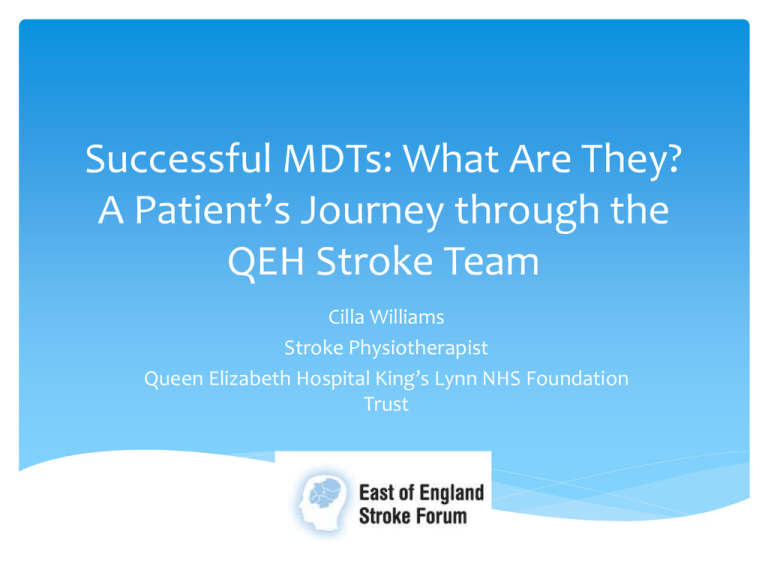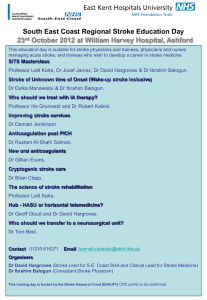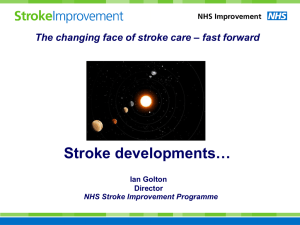F. Successful MDTs - What are they - Cilla Williams
advertisement

Successful MDTs: What Are They? A Patient’s Journey through the QEH Stroke Team Cilla Williams Stroke Physiotherapist Queen Elizabeth Hospital King’s Lynn NHS Foundation Trust Who are we? 28 bed (+ 1 thrombolysis bed) stroke unit, combining acute stroke and stroke rehabilitation 545 strokes per year Ward manager – Sister Diane Benefer Consultants – Raj Shekhar, James Phillips, Umesh Rai Stroke OT/PT Team Lead - Anne-Marie Hurst QEH Stroke AHPs cover entire stroke pathway (successful bid in 2008) What is teamworking in Stroke? A coordinated multidisciplinary team that meets at least once a week for the interchange of information about individual patients (RCP, 2012) Staff should have specialist expertise in stroke and rehabilitation (RCP, 2012) Stroke units should have multi-disciplinary notes (Clarke, 2010) Is that it??!!! What is real teamworking in Stroke? Current measures of teamworking in stroke are inadequate Location of staff, frequency of team contact, team size, management structure, defined team membership and shared goal planning are key determinants of teamworking practice (Baxter & Brumfitt, 2008a) The inpatient journey – an overview Discussed at 8.45am board round Commence discharge planning Patient and Carer Feedback to board round Assessment and treatment by MDT Board round Board round 30 minute MDT meeting held in day room, 5 days per week Exceptional multi-professional attendance – doctors (including consultants), specialist stroke nurses, physiotherapists, occupational therapists, speech & language therapists, stroke coordinator sister, dietician, social worker, clinical psychologist, Stroke Association Coordinator Week to view documentation “I don’t think decisions are made above your head, they involve you” (Patient Experience Survey 2012) A typical day – joint working A typical day – joint working Patient with midbrain infarct, presenting with reduced postural control, aphasia, ptsosis, visual disturbance, dysphagia Tilt table session in stroke therapy gym with PT and Therapy Assistant (dual OT/PT), as well as……. SLT Orthoptist A typical day –opportunistic dialogue Unplanned, problem orientated interaction between team members unconstrained by location, time, or team member status (Clarke, 2010) Occurs on the ward, in the day room, in the therapy gym, in the therapy office Close proximity to Wheelchair Services, Social Services departments Not only with staff members but also patient and carers A typical day –opportunistic dialogue A typical day… Comprehensively trained staff Electronic nursing handover updated by all of the team Six day PT & OT Stroke service Early inpatient contact with Stroke Association Information, Advice and Support Coordinator Discharge Planning Dedicated Stroke Coordinators (1 WTE) Discharge Planning Assistant (0.5 WTE) Formal meeting with patient and carer if required Community Stroke Team Comprehensive therapy discharge summary In the community Monthly MDTs and interdisciplinary MDT training Stroke Association Communication Group Advice/support Prevention Long term support groups What do others say? “They demonstrate true interdisciplinary working” Liz Bennett, Anglia Stroke Network Lead The integrated physiotherapy and occupational therapy services “reduces duplication and increases effectiveness and efficiency of service delivery” Caroline Hayden-Wright, Rehabilitation Services Review, October 2012 What do our patients say? “My family and I wish to express our gratitude and admiration for this team of talented health care professionals” Patient AS, September 2012 “Seems to be a well practised unit” “Absolutely brilliant” [about QEH Stroke Unit] Patient Experience Survey 2012 The results? QEH Stroke Team achieved a total organisational score of 89.1 in the SSNAP 2012 (national average 73.3) For the future… Service user participation in service development Restructuring our community service 6 month reviews Conclusion Effective team work is complex and requires frequent contacts at a variety of levels, not only between professions but with patients and their carers Successful interdisciplinary working is vital in stroke but national guidelines do not go far enough when describing what makes teams most effective The QEH Stroke Team demonstrates a range of qualities of effective team work including co-location, good leadership, skilled staff, joint working and opportunistic dialogue The patient and their carer will be physically or virtually present at every stage of the pathway Any questions? ? References Baxter, S. K. & Brumfitt, S. M. (2008a) Once a week is not enough: evaluating current measures of teamworking in stroke. Journal of Evaluation in Clinical Practice, 14, 241-247. Baxter, S. K. & Brumfitt, S. M. (2008b) Benefits and losses: a qualitative study exploring healthcare staff perceptions of teamworking. Quality Safety Health Care, 17, 127-130. Clarke, D. J. (2010) Achieving teamwork in stroke units: The contribution of opportunistic dialogue. Journal of Interprofessional Care, 24 (3), 285-297. Enefer, C. & Scantlebury, K. (2012) Patient Experience: Patient Satisfaction Interviews (West Raynham Stroke Unit), QEH Audit Dept. Hayden-Wright, C. (2012) Review Rehabilitation Services Queen Elizabeth Hospital King’s Lynn. References (continued) Monaghan, J., Channell, K., McDowell, D. & Sharma, A. K. (2005) Improving patient and carer communication, multidisciplinary team working and goal-setting in stroke rehabilitation. Clinical Rehabilitation, 19, 194-199. RCP (2012) National Clinical Guideline for Stroke, 4th Edition, London, Royal College of Physicians. RCP (2o12) Sentinel Stroke National Audit Programme (SSNAP) Acute organisational audit report, London, Royal College of Physicians. Suddick, K. M. & De Souza, L .(2006) Therapist’s experiences and perceptions of teamwork in neurological rehabilitation: reasoning behind the team approach, structure and composition of the team and teamworking processes. Physiotherapy Research International, 11 (2), 7283.







